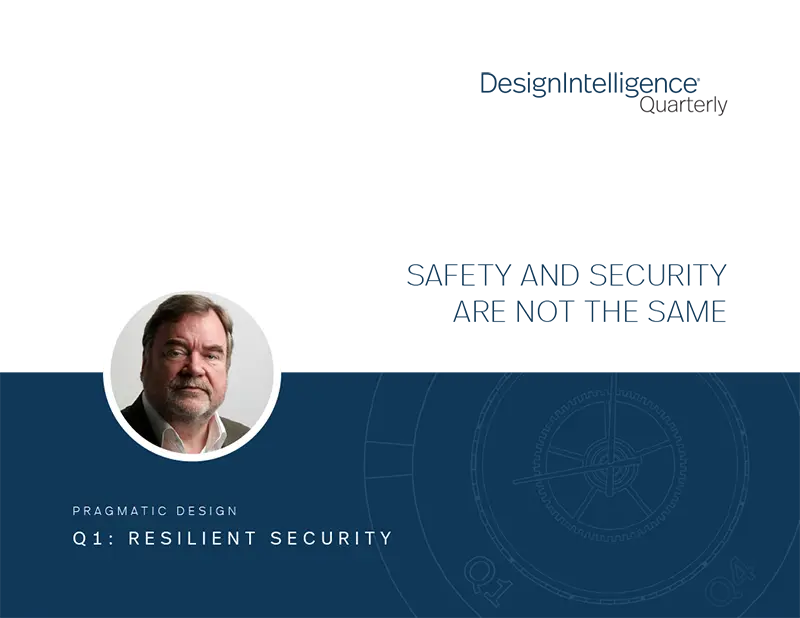Safety and Security Are Not the Same
by Paul Finch
Programme Director, World Architecture Festival
February 8, 2023
Letters From London: Paul Finch examines and applies some basic principles of defense in architecture.
The relationship between architecture and security is, and has always been, a consequence of political, legal and military considerations — all part of the human dynamic.
Over centuries, solutions responding to the human need for security have produced various highways and byways in the journey of architectural history. In some of these syntheses, security has had little significance. In others, it has been the only thing that matters.
The terms “safe” and “secure” can be used interchangeably, especially when applied to products like a safe, which provides security for its contents. Applied to architectural design, the terms are very different. In architecture, safety might be described as a matter controlled by regulation of structure, fire or exiting. But security is a vastly different concept, a condition beyond the boundaries of general regulation, more likely to involve codes of conduct or accepted industry or military standards.
Applications
Residential
In the U.K., a programme called Secure by Design is intended to encourage certain kinds of residential development. This programme is not without controversy, with the winds of fashion sometimes suggesting that cul-de-sacs are more secure than normal streets because there is no obvious escape route. But sometimes not. Some design proselytisers claim that certain forms of architecture encourage criminal behaviours and are inherently the enemies of security or unintentional generators of insecurity. These claimants allege that “traditional” housing is less of a nurturing ground for criminality than high-rise, working-class estates.
As far as London is concerned, this is largely nonsense. The most notorious criminal gangs of recent decades were all brought up in traditional terraced homes, but this did not stop gangs like the Krays and the Richardsons from nailing their rivals to floorboards — no doubt a reflection of the homes in which they were brought up.
Intelligence
The “safe houses” used by the intelligence community might be better described as “secure locations.” And security from criminality or military attack has given rise to a long line of architectural, planning and construction thinking that responds to advances in military and other technological forms. The importance of location can scarcely be underestimated when creating secure buildings, neighbourhoods and cities. The illegal invasion of Ukraine is a current example of how rivers, contribute to the security of cities, or at least parts of them. Geography and geology influence design and locational considerations, which then reinforce their importance following the establishment of buildings and even some cities, which follow military archaeologies.

Defense
Castles are examples of these location-critical principles. Most are created in commanding locations and are relatively easy to defend against anything except a long siege, Troy being the obvious case in point. Geography helps too. Take the coastline of Oman in the Persian Gulf, which has seen successive waves of conquest, though no invader ever managed to seize the country’s inland forts. But that quality becomes less relevant when we realize that anywhere in the world could now be the subject of aerial bombardment or remote-controlled missiles. (One of the reasons the U.S. embassy in London moved was the extraordinary cost that would have been incurred in strengthening the Grosvenor Square building’s roof to bring it up to acceptable standards.) Military history would be very different if it were true that aerial warfare is inevitably successful. But it is not always, unless nuclear strikes are deployed (or illegal gas bombs, as used by the government in Syria against civil war rebels).
Most contemporary wars are won in the old-fashioned way, by taking streets and cities with soldiers on the ground. Even in victory, conquerors can soon lose everything they took as a result of “peace” negotiations. A good example is in Afghanistan, where all the military camp-building and social and educational initiatives appear to have come to nothing following the withdrawal of Western troops.
The security of buildings closer to home is another matter. One of the most secure buildings in the U.K. is the Government Communications Headquarters (GCHQ), the intelligence headquarters in Cheltenham that monitors millions of communications worldwide every day for the government and armed forces of the country. Completed in 2003 to designs by Gensler, the doughnut-shaped complex houses more than 5,000 workers, analysts and cryptographers. If you go there, you will see battered walls reminiscent of medieval fortresses, though everything else is gleamingly high-tech (in the manner of the Freedom Tower in New York City). This building, which demanded security as its core purpose, rightfully looks as though it is.
Invisible Integral Solutions
Security can also be built-in and hidden. For example, in the many decades since their independence in 1965, houses and apartments in Singapore were required to incorporate protected rooms encased in concrete as a response to the perceived threat of bombing by Malaysia. These were often used as drying rooms, for storage or as accommodation for a maid.
High-rise construction was, in part at least, a response to the perceived threat of bombing after World War I, since it was thought more difficult to hit a tower than linear, low-rise construction. Designs were also developed with independent ventilation systems to combat the associated threat of poison gas. Fortunately, the demand for these systems never became widespread, partly because of international convention against this form of warfare.
Just how secure can a tall building be? In the immediate aftermath of 9/11, there were suggestions that high-rises as a building form might stop and that underground car parks might be banned because of the possibility of bombs being left in parked cars. In the years following, the world has decided to be more optimistic. High-rise buildings have again become increasingly common across the world, with relatively low levels of security. There has even been a return to the idea of public lobbies on the ground floor, so common for so long in cities like New York and Chicago.

Systems and Human Solutions
These days, we rely more on data monitoring and surveillance — the observation of people in places — to provide appropriate security levels. This explains why visitors aren’t required to go through airport-style security checks to get into retail malls. Covert scanning in major city centres is a matter of controversy but has been accepted by Londoners. London has the highest number of CCTV cameras per capita of any city, but they wouldn’t necessarily stop an invasion.
As we continue to learn and adapt to our constantly changing world and the evolving methods of those who seek to threaten us, we need constant vigilance by designers and enforcers, and by all who use and occupy our buildings, to ensure our basic needs for safety and security. Beyond reactive responses and thicker walls, we need not forgot that our intentions, behaviours and humanity comprise other necessary parts of these complex systems.
Paul Finch is the director of the World Architecture Festival and a regular contributor to DesignIntelligence.


